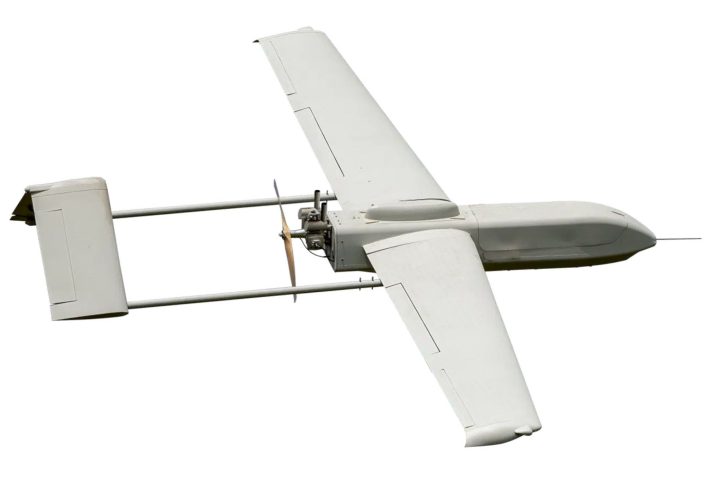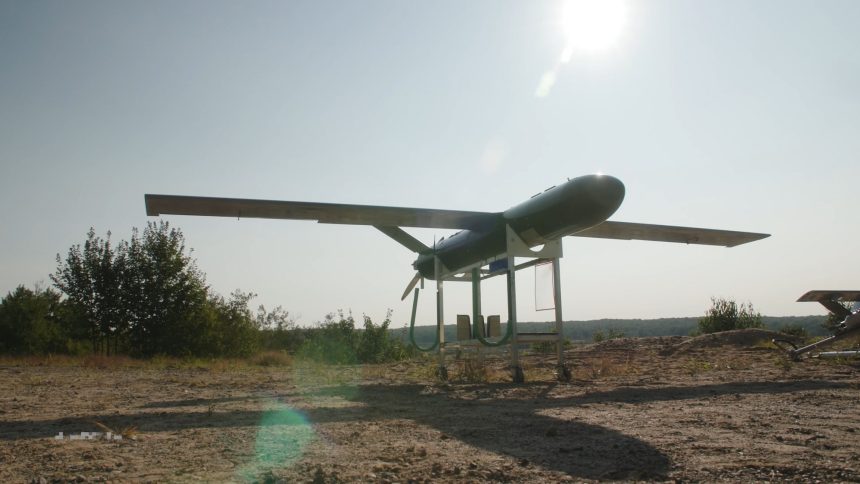AEVEX produces two one-way attack drones, described as Group 3 UAS, as part of the Phoenix Ghost family. While the Dominator was already present on the company’s website, the Disruptor was publicly unveiled only now, although they are being used in Ukraine since 2022.
The secretive U.S.-made Phoenix Ghost loitering munitions, which are reportedly being used by Ukraine since 2022, were publicly displayed for the first time last week at the AUSA (Association of the US Army) symposium in Washington D.C. The Pentagon first announced the systems were headed for Ukraine in Apr. 2022, part of a $800 million package. Since then, however, no details were disclosed about the systems and their capabilities, as well as images or even concept renderings.
Developed by AEVEX Aerospace, the munition has now been revealed to be part of a family of drones, and not just a single design. The War Zone quoted AEVEX’s senior director of business development Elizabeth Trammel, who said the system has “been around for a while,” adding they had “received specific permission to talk about it” during the symposium.
Two one-way attack drones models, both with push-motor configurations, have now been acknowledged as part of the Phoenix Ghost family of loitering munitions. Both are Group 3 Unmanned Aerial Systems (UAS) which, according to the classification adopted by the U.S. Department of Defense, have a Maximum Take Off Weight between 55 and 1,320 lb, normal operating altitudes between 3,500 ft and FL180 and speed between 100 and 250 kt.
The first model is the Disruptor, which was publicly unveiled this week, while the other is the Dominator, which AEVEX already showed on its website. TWZ added that the drones’ development began under the Air Force’s Big Safari special projects office, predating the Russia-Ukraine war in 2022.
The Phoenix Ghost munitions then became some of the firsts provided by the United States to Ukraine, although there wasn’t visual evidence of them in action. A video from Aug. 2022 claimed the drone was used in action on a group of Russian ground troops, although the video only showed an overhead UAV’s view of the area without the Phoenix Ghost clearly visible.

Disruptor and Dominator
AEVEX’s website explains that its “loitering munitions use visual-based navigation to autonomously identify and follow landmarks or features in their environment, enabling precise positioning and pathfinding without reliance on GPS.” Such capability is becoming increasingly important on today’s battlefields where Electronic Warfare plays a big part, with GPS jamming being almost constant. “Our systems leverage alternative PNT (Position, Navigation and Timing) solutions to maintain precise navigation and operational capability in GPS-denied or degraded environments,” further mentioned the website.
Disruptor is based on a tubular carbon fiber fuselage, with straight wings and a v-tail configuration. The munition is reported being 10.1 ft (3 m) long and with a wingspan of 15.75 ft (4.8 m). The design has a maximum takeoff weight of 185 lb (84 kg) when launched pneumatically, or 205 lb (93 kg) by using a rocket-assisted launch.
TWZ added that the Disruptor’s small internal combustion engine, which drives a two-bladed pusher propeller, gives it an endurance of 4.5 hours at a range of 372 miles (598 km) with a 50 lb (about 23 kg) payload. An Electronic Fuel Injection (EFI) engine variant enhances the munition’s endurance and range to 11 hours and 822 miles (1,322 km) respectively.
The Dominator, on the other hand, with a length of 4.9 ft (1.5 m), a 16.4 ft (5 m) wingspan and weight of 100 lbs (45.3 kg), can fly for over 5 hours at more than 270 NM (500 km). The munition can carry a payload of 36.8 lbs (16.7 kg) consisting of a fragmentation or penetrator warhead, as well as an optional ISR configuration. It is configured with a mesh radio and hardened GNSS solution to operate in heavy jamming and GPS/SATNAV-denied environments.
Finally we have the image of the Phoenix Ghost UAV.
Secretive Phoenix Ghost Kamikaze Drones Rushed To Ukraine Finally Come Out Of The Shadows
The Phoenix Ghost is not a single design, but a family of attack munitions from AEVEX Aerospace.https://t.co/gDpGQR6cXH https://t.co/Dpu5hVYbfq pic.twitter.com/EWoHnVGzxY
— 𝔗𝔥𝔢 𝕯𝔢𝔞𝔡 𝕯𝔦𝔰𝔱𝔯𝔦𝔠𝔱△ 🇬🇪🇺🇦🇺🇲🇬🇷 (@TheDeadDistrict) October 19, 2024
Capabilities
The loitering munitions can “automatically detect, identify, locate, report (DILR) and deliver lethal and non-lethal effects against threats across multiple scenarios and domains with unprecedented accuracy and speed,” says the company. They are also able to “navigate, make decisions, and complete missions without direct intervention,” adds AEVEX on its website.
The UAVs are compatible with line-of-sight links with modules for “precision attack, ISR [Intelligence, Surveillance and Reconnaissance], communication relay, full spectrum EW [Electronic Warfare], cyber effects or precision sensor emplacement.” AEVEX also says the UAVs are “attritable yet fully recoverable.”
While the number of systems donated to Ukraine has not been specified, the firm says over 5,000 have been delivered “to users via multiple U.S. government contracts,” right beside a graphic saying this is the “number 1 U.S. government-provided loitering munition to support the conflict in Ukraine.” AEVEX also added that its loitering munitions are “designed with open architecture principles that support interoperability and customization, enabling the integration of third-party sensors, software, and payloads.”
The drones reduce the reliance on SATNAV (Satellite Navigation) signals, like the GPS, by using “visual-based navigation to autonomously identify and follow landmarks or features in their environments, enabling precise positioning and pathfinding.” GPS and SATNAV have been very vulnerable to Russian EW, affecting the performance of many Western weapons.
Phoenix Ghost drones, integral to Ukraine’s defense, remain enigmatic yet powerful tools, famed for adaptability and stealthy operations. Real remains elusive. https://t.co/Hgrm3byt7d pic.twitter.com/zk6QKQwfTf
— Sara Robinson (@SaraSweetSoul) October 18, 2024
Videos on AEVEX’s website shows a Group 2 drone, the Atlas, striking shipping containers, representing the ability to hit light tactical targets like bunkers and entrenched defensive positions. The “attritable” UAVs that are designed and manufactured with “modularity” and “open systems architecture”, aid scalability and, like the Switchblade series of tube-launched loitering munitions, are critical for breaking deadlocks in grinding, bloody and high-casualty trench or urban warfare such as the ones witnessed in south Donetsk and Bakhmut in 2023.









